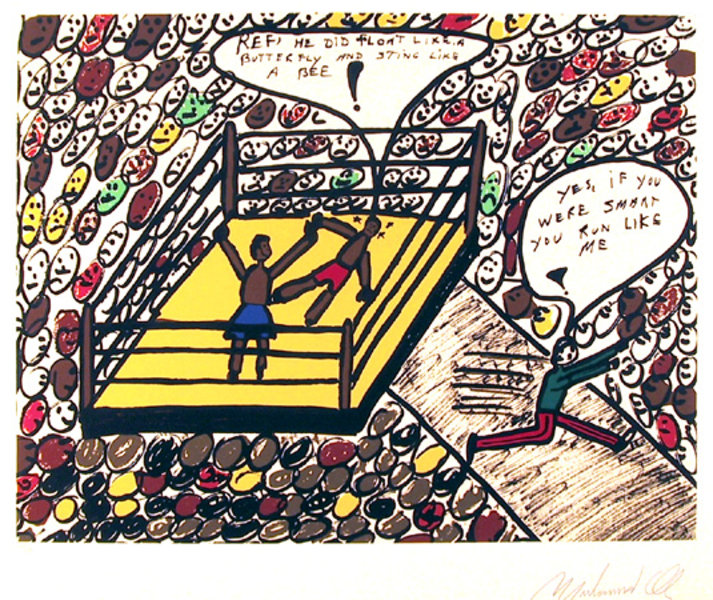Muhammad Ali – the Artist?
The boxing great’s legacy proves he offered more to the world
Muhammad Ali’s highest grossing art piece “Sting Like a Bee” sold for $425,312.
December 2, 2021
Muhammad Ali is widely known as a legendary boxer; however, it is largely unknown that he was also an avid artist. Through his famous words, “Float like a butterfly, sting like a bee,” Ali embodied the essence of fluidity and gracefulness in the ring, as well as on the canvas. According to the Washington Post’s Annabelle Timsit, Ali’s artwork sold for a cumulative sum of nearly one million dollars at an auction in New York City. Ali was an icon in every sense of the word, which easily explains the eagerness of the participants in the auction to obtain his now legendary work.
Ali, who passed away in 2016 at the age of 74, following a long and arduous bout with Parkinson’s disease, remains an iconic and legendary figure today. The art placed for bid in the auction was supplied by Ali’s friend and mentor, acclaimed military history author, Rodney Hilton Brown. Ali derived his love of art from his father, Cassius Clay Sr., and often sought-out sports artist, Leroy Neiman, who was an avid attendee of his fights, for lessons.
Rodney Hilton Brown states in his book, Muhammad Ali – The Untold Story: Painter, Poet & Prophet, that Ali often said, “I draw pictures with meanings.” This underlines his depth as a person and the depth of thought that he put into his work.
In much the same way as Ali, art teacher Madison Grubbs uses art to express herself and teaches students to do the same.
“Meaning is the ultimate purpose of creative work. To me, adding a deeper meaning to your work is a way to visually communicate with others in a way that words cannot express,” Grubbs said.
The auction was held by the British auction house, Bonhams, in New York and called “TCM Presents…It’s a Knockout!.” It included over 30 of Ali’s art pieces, among other Ali-related items, such as his match-worn boxing gloves. The two highest grossing art pieces sold were “Sting Like a Bee,” (1978), going for $425,312, which Ali created during the filming of Freedom Road, a historical drama he was starring in in Mississippi; and “I Love You, America,” (1979), which sold for $150,312. Along with his status as a legendary boxing icon, Ali was an activist during the civil rights movement, famously taking temporary leave from boxing in order to protest the Vietnam War by refusing the draft and ultimately winning his Supreme Court case.
His activist spirit was evident in his set of five pieces entitled “Let My People Go.” Ali’s pieces helped to influence and bolster the civil rights movement, helping to frame him as one of the most essential and influential activists of his time.
Libby Cheek (10) recognizes Muhammad Ali’s legacy and was intrigued to learn of his art career.
“Muhammad Ali was courageous and advocated for black resistance during the civil rights movement,” Cheek said.
Ali continues to be a role model through his legacy as both a boxer and an artist. His influence transcends time, as he continues to inspire today’s youth. A generation of boxers and activists – as well as artists – aspire to be like Ali. Muhammad Ali, without doubt, led a truly legendary and fulfilled life and career. He wasn’t wrong when he proudly declared, “I am the greatest!”




